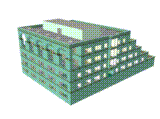Interactive Architectural Walkthroughs

Thomas A.
Funkhouser
Overview:
Interactive computer programs that simulate the experience of "walking"
through a building interior are useful for visualization and evaluation
of building models before they are constructed. However, realistic-looking
building models with furniture may consist of millions of polygons and
require gigabytes of data - far more than today's workstations can render
at interactive frame rates or fit into memory simultaneously. In order
to achieve interactive walkthroughs of such large building models, a system
must store in memory and render only a small portion of the model in each
frame; that is, the portion seen by the observer. As the observer "walks"
through the model, some parts of the model become visible and others become
invisible; some objects appear larger and others appear smaller. The challenge
is to identify the relevant portions of the model, swap them into memory
and render them at interactive frame rates (at leastfifteen frames per
second) as the observer's viewpoint is moved under user control.
We have developed a system that supports interactive walkthroughs of such
large, fully furnished building models. The system relies upon an efficient
display database that describes the model as a set of objects, each of
which is represented at multiple levels of detail; and contains an index
of spatial cells with precomputed visibility information. Adaptive display
algorithms are used to compute the set of objects potentially visible from
each observer viewpoint, and to choose an appropriate level of detail at
which to render each object to maintain an interactive frame rate. Real-time
memory management algorithms are used to predict observer motion and pre-fetch
objects from disk that may become visible in future few frames. Using these
techniques, the system is able to maintain over 15 frames/second during
walkthroughs of building models containing over one million polygons.
This is joint work with Carlo
Sequin, Seth Teller,
and the UC
Berkeley Walkthru Group.
Related Links:
Related Publications:
-
Alex Biliris, Thomas A. Funkhouser, William O'Connell, and
Thimios Panagos.
BeSS: Storage Support for Interactive
Visualization Systems.
ACM-SIGMOD 1996 International Conference on Management
of Data, Montreal, Quebec, May, 1996, p. 556.
-
Thomas A. Funkhouser.
Database Management for Interactive
Display of Large Architectural Models.
Graphics Interface `96, Toronto, Ontario, May,
1996, p. 1-8.
-
Thomas A. Funkhouser, Seth J. Teller, Carlo H. Sequin, and
Delnaz Khorramabadi.
The UC Berkeley System for Interactive
Visualization of Large Architectural Models.
Presence, 5 (1), January, 1996.
-
Thomas A. Funkhouser.
Database and Display Algorithms
for Interactive Visualization of Architectural Models.
PhD Thesis, Computer Science Division, UC Berkeley, September,
1993.
Also available as UC Berkeley Technical Report UCB/CSD93/771.
-
Thomas A. Funkhouser and Carlo H. Sequin.
Adaptive Display Algorithms for
Interactive Frame Rates During Visualization of Complex Virtual Environments.
Computer Graphics (SIGGRAPH `93), Los Angeles,
CA, August, 1993, p. 247-254.
-
Thomas A. Funkhouser, Carlo. H. Sequin, and Seth J. Teller.
Management of Large Amounts of
Data in Interactive Building Walkthroughs.
Computer Graphics (1992 SIGGRAPH Symposium on Interactive
3D Graphics), Boston, MA, March, 1992, p. 11-20.

